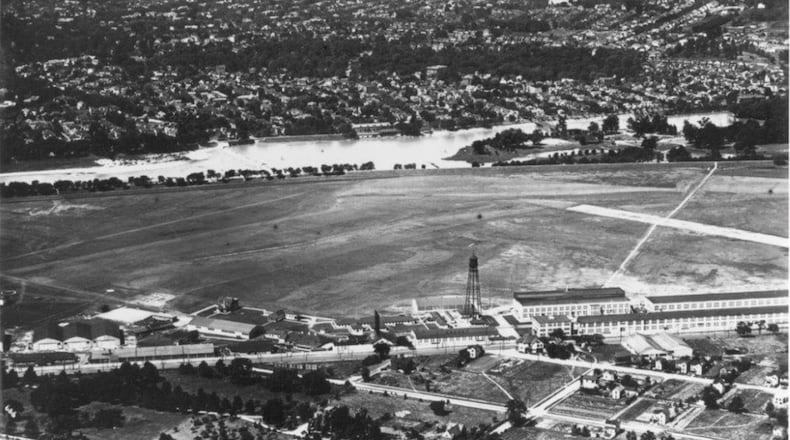Dayton industrialist Edward A. Deeds, who served on several wartime production boards, was able to assist his local community in acquiring not one, but three, military installations. He knew all about the Huffman Prairie and Dayton’s aviation heritage. As president of the Miami Conservancy District, Deeds also knew that the district was sole owner of the area behind Huffman Dam. This made it easy for the government to lease or purchase the entire parcel “at a very low cost.”
The deal was sealed May 22, 1917, when the Army Signal Corps signed a lease for 2,075 acres of land between what is now Huffman Dam and the City of Fairborn. On June 6, the Signal Corps named the facility Wilbur Wright Field after Dayton’s pioneering aviator who died in 1912. Operations at the Field began June 28 when schools for pilots, mechanics and armorers opened. The schools would train more than 100 pilots, about 2,000 mechanics and 485 armorers.
The Signal Corps also acquired land for a centrally located aviation general supply depot to support the field along with others in Illinois and Michigan. On June 10 the Signal Corps paid $8,000 to purchase a 40-acre triangular tract of land adjacent to Wilbur Wright Field. That tract became the Fairfield Air Depot.
The depot provided everything from airplane parts and engines to shoes laces. Bldg. 1 in Area A opened in January 1918 as the depot headquarters and warehouse (thus the railroad tracks inside).
Dayton’s third installation met the Signal Corps’ need for a temporary aviation experimental engineering station. Deeds suggested a 120-acre site adjoining Triangle Park between the Miami River and present-day Keowee Street known as North Field. Dayton was considered an ideal location because it was in the middle of the nation’s industrial region, was centrally located near major aeronautical manufacturing agencies and had a local pool of trained labor. However, a debate arose between North Field and a competing South Field site.
North Field won and on Oct. 3 a lease was signed for the 254.37 acres. The field was named McCook Field in honor of Dayton’s McCook family, which had achieved fame as the “Fighting McCook” family in the Civil War.
On Oct. 13 McCook became the official headquarters of the Airplane Engineering Division. McCook’s engineers and technicians researched, developed, manufactured, tested and evaluated military aircraft and all of their associated components and equipment.
Cooperation between Wilbur Wright and McCook Fields began in 1918 when the former agreed to let McCook use hangar and shop space as well as its enlisted mechanics to assemble and maintain airplanes and engines. Wilbur Wright Field’s large, open flying field proved ideal for testing experimental aircraft and the larger, more powerful models developed during the 1920s.
The training schools closed at the end of World War I, and Wilbur Wright Field soon merged with the depot, which was active until 1946. McCook Field remained operational until 1927.
WPAFB marks a 100 years of aviation achievement
This article is the first of a 4-part series, highlighting the centenary of Wright-Patterson Air Force Base, tracing its origins from the Wright brothers’ operations to today’s role as a leader of Air Force research, development, acquisition, logistics and training. Upcoming historical features in the Skywrighter will include:
Part II: Wright-Patt Forges the Air Arsenal of Democracy (1924 and 1948)
Part III: Wright-Patt through the Cold War (1948-1989)
Part IV: WPAFB Responds to Terrorism and a New Century (1990-today)
About the Author
